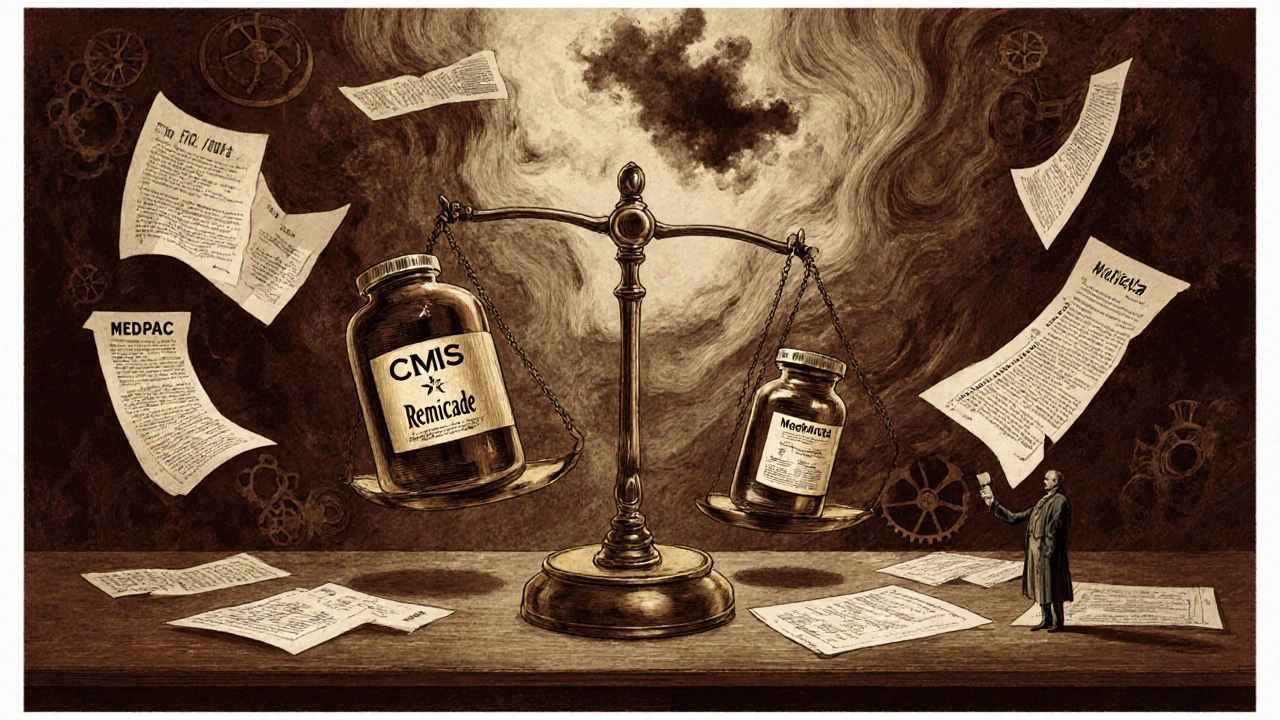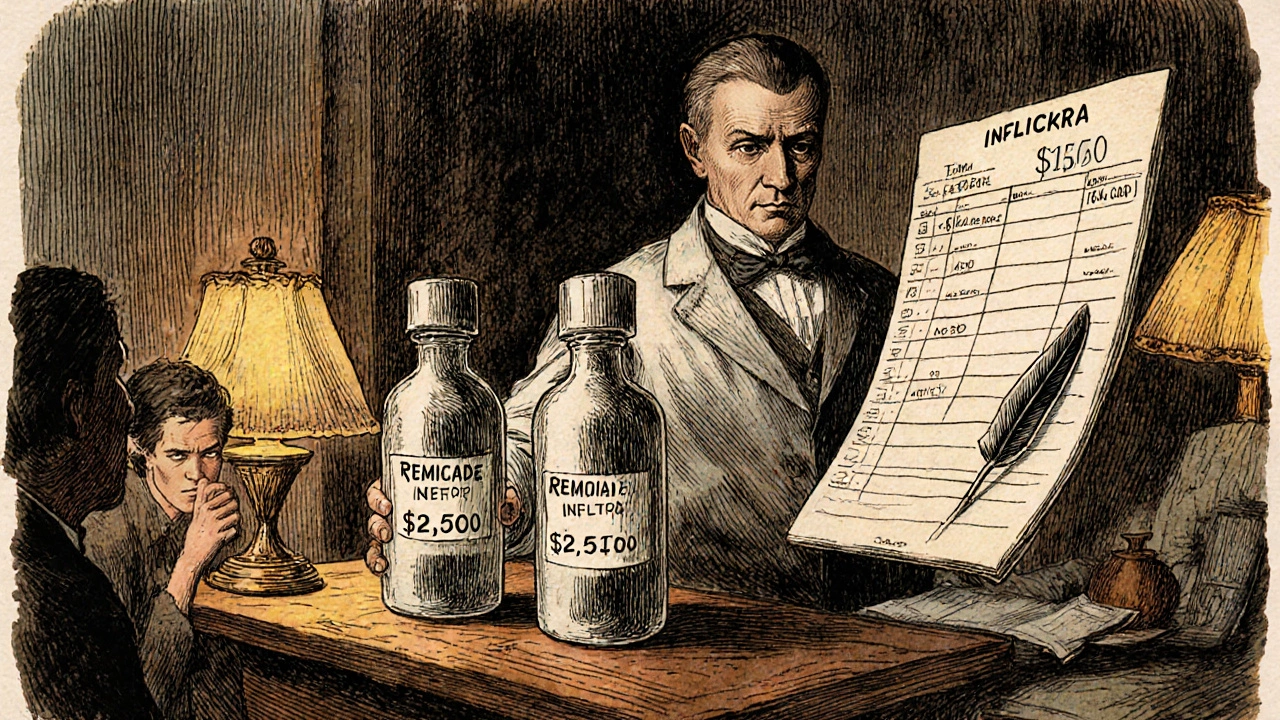- 8
When a doctor gives a patient a biosimilar drug like Inflectra or Renflexis instead of the brand-name Remicade, the billing process isn’t as simple as swapping one pill for another. Unlike generic small-molecule drugs, biosimilars are complex biological products made from living cells. That complexity shows up in how they’re coded, billed, and paid for - especially under Medicare Part B, which covers drugs given in doctors’ offices and clinics. If you’re a provider, pharmacist, or even a patient wondering why your bill looks different, understanding the system is key.
How Biosimilars Are Coded Differently Than Generics
Generic drugs use the same National Drug Code (NDC) as their brand-name counterparts and are billed under a single code. Biosimilars? Each one gets its own unique HCPCS code. That’s because the FDA treats them as distinct products, even though they’re highly similar to the reference biologic. After FDA approval, CMS assigns a temporary Q-code (like Q5101 for early infliximab biosimilars) or a permanent J-code (like J1745 for Inflectra). These codes are updated quarterly in the Medicare Physician Fee Schedule.
Before 2018, all biosimilars for the same reference drug shared one code. That created a problem: if one biosimilar entered the market at a lower price, others could ride on its reimbursement rate without lowering their own. The 2018 policy change fixed that by giving each biosimilar its own code and payment rate. Now, Inflectra, Renflexis, and Avsola each have separate codes and get paid based on their own Average Selling Price (ASP), not a blended average.
How Medicare Pays for Biosimilars
Medicare Part B pays for most physician-administered drugs at 106% of the ASP. That’s 100% of the drug’s actual selling price, plus a 6% add-on to cover handling and administration costs. For biosimilars, the rule is simple: 106% of the biosimilar’s own ASP. But here’s the twist - the 6% add-on is calculated based on the reference product’s ASP, not the biosimilar’s.
Let’s say Remicade sells for $2,500 per dose, and Inflectra sells for $2,000. Medicare pays the provider:
- For Remicade: 100% of $2,500 + 6% of $2,500 = $2,650
- For Inflectra: 100% of $2,000 + 6% of $2,500 = $2,150
That means the provider makes $150 more per dose with Remicade than with Inflectra - even though Inflectra costs $500 less to buy. That $30 difference in add-on revenue creates a financial disincentive for providers to switch, even when the biosimilar is cheaper for the patient and the system overall.
The JZ Modifier and Discarded Drug Rules
Starting July 1, 2023, CMS added another layer: the JZ modifier. This modifier must be added to claims when no drug is discarded during administration - meaning the full vial was used. For drugs like infliximab, which come in 100mg or 500mg vials, providers often draw multiple doses from one vial. If they use the whole vial, they use the JZ modifier. If they throw away any amount, they don’t use it.
This sounds technical, but it matters. Incorrect use of the JZ modifier leads to claim denials. One gastroenterology practice reported a 30% spike in billing staff time after the rule rolled out. Providers now need to track exactly how much was used per vial and document it. Many clinics started using electronic health record alerts or double-checklists to avoid errors.

Why This System Slows Adoption
The U.S. biosimilar market hit $12.3 billion in 2022, but only accounts for about 18% of the total biologics market. Compare that to Europe, where biosimilars make up 75-85% of the market for similar drugs. Why the gap?
It’s not just about price. It’s about payment structure. In Germany or the UK, biosimilars often win contracts through tendering systems - the lowest bidder gets the majority of prescriptions. In the U.S., the 6% add-on tied to the reference product’s price means providers still profit more from the expensive drug. A 2020 analysis from MIT found that eliminating the reference product’s ASP from the add-on calculation could boost biosimilar use by 15-20 percentage points.
Providers know this. A 2022 survey of 217 cancer centers found that despite cost savings, many still prescribed the reference biologic because reimbursement was higher. Even when a biosimilar was 20% cheaper, utilization stayed under 25% in some practices.
What Providers Need to Do to Get Paid Right
Getting reimbursement right requires three things: correct coding, accurate documentation, and timely updates.
- Use the right HCPCS code - Check CMS’s quarterly updates. Outdated codes cause 22% of initial claim denials, according to Fresenius Kabi’s 2023 guide.
- Apply the JZ modifier correctly - Only use it when no drug is discarded. If you open a 500mg vial and give two 100mg doses, you’re discarding 300mg - no JZ modifier.
- Verify payer differences - Medicare Part B pays 106% ASP. Medicare Advantage plans may pay 100-103%. Commercial insurers vary wildly. Always confirm before billing.
Successful practices use dual verification: pharmacy staff check the administered product against the billing code before submission. One oncology network reduced billing errors from 15% to under 3% using this method.

What’s Coming Next
CMS is considering major changes. In early 2023, it asked for public input on alternatives to the current 6% add-on model. Options include:
- A fixed-dollar add-on (e.g., $150 per dose, regardless of drug price)
- Removing the reference product’s ASP from the biosimilar’s add-on calculation
- Consolidated billing - paying all drugs in a class (reference + biosimilars) at 106% of the volume-weighted average ASP
MedPAC recommended the last option in June 2023. If adopted, it could push U.S. biosimilar adoption from 35% to 65-70% by 2030. The Congressional Budget Office estimates that could save Medicare $3.2 billion over ten years.
But there’s a catch: if biosimilar manufacturers make less profit, they might stop developing new ones. The system walks a tightrope - encouraging competition without killing innovation.
Bottom Line: It’s Complicated, But Improving
Biosimilar billing is messy. It’s not like generics. The codes change. The modifiers matter. The payments don’t always match the savings. But the system is evolving. Providers who stay updated, use checklists, and track CMS updates are seeing fewer denials and better compliance.
For patients, this means more affordable options are coming - but only if the payment system catches up. Right now, the savings are real, but the incentives aren’t aligned. If CMS changes how it calculates the add-on, we could see a real shift. Until then, the best way to get the right reimbursement is to know the code, track the vial, and double-check the modifier.
Do biosimilars use the same HCPCS code as the reference biologic?
No. Each FDA-approved biosimilar gets its own unique HCPCS code - either a temporary Q-code or a permanent J-code. The reference biologic keeps its own separate code. This change started in 2018 to ensure each biosimilar is paid based on its own price, not a blended average.
Why do providers sometimes prefer the brand-name biologic over the biosimilar?
Because Medicare Part B pays providers 106% of the reference product’s ASP for the add-on portion, not the biosimilar’s. For example, if Remicade costs $2,500 and Inflectra costs $2,000, the provider gets $150 in add-on revenue for Remicade and only $120 for Inflectra. That $30 difference per dose makes the higher-priced drug more profitable, even if the biosimilar is cheaper to buy.
What is the JZ modifier and when do I use it?
The JZ modifier indicates that no drug was discarded during administration. You use it only when the entire vial was used. For example, if you draw two doses from a 500mg vial and use all of it, you add JZ to the claim. If you throw away any amount, you don’t use it. This rule, effective July 1, 2023, applies to infliximab and its biosimilars. Incorrect use leads to claim denials.
How often are biosimilar payment rates updated?
CMS updates biosimilar payment rates quarterly, based on the Average Selling Price (ASP) data reported by manufacturers. The updated rates are published in the Medicare Physician Fee Schedule, typically in January, April, July, and October. Providers must check these updates to avoid using outdated codes or incorrect payment amounts.
Are biosimilars covered the same way by Medicare Advantage plans?
Not always. Medicare Part B pays 106% of ASP for biosimilars. Medicare Advantage plans, which are run by private insurers, often pay less - typically 100% to 103% of ASP. Some plans may also require prior authorization or step therapy. Always verify coverage with the specific plan before administering the drug.
What’s the biggest mistake providers make when billing for biosimilars?
Using the wrong HCPCS code. Many claim denials happen because providers use an outdated or incorrect code - like the old blended code Q5101 instead of the current J-code for a specific biosimilar. Another common error is forgetting to apply the JZ modifier when no drug is discarded. The best defense is a checklist and cross-checking the administered product against CMS’s latest coding guide.
What to Do Next
If you’re a provider, start by downloading the latest CMS Physician Fee Schedule update. Bookmark the Medicare Learning Network page for biosimilars. Train your billing team on the JZ modifier and code changes. If you’re a patient, ask your doctor: "Is there a biosimilar option?" - and if so, what’s the cost difference to you.
The system isn’t perfect. But it’s getting better. The real question isn’t whether biosimilars work - they do. The question is whether the payment system will catch up to the savings they offer. Until then, attention to detail in billing is the only way to make sure both patients and providers benefit.


Emma louise
November 28, 2025 AT 04:00This whole system is a joke. We pay $2,500 for Remicade and get slapped with a $150 profit margin on a $2,000 biosimilar? The pharma giants are laughing all the way to the bank while patients struggle. Congress? They’re too busy taking donations to fix this. It’s not about healthcare-it’s about corporate welfare disguised as policy.
Lauren Zableckis
November 30, 2025 AT 00:45The JZ modifier is such a tiny detail that causes massive headaches. I’ve seen clinics waste hours just tracking vial usage. It’s bureaucratic overkill for something that should be simple. The real win would be standardizing payment across all drugs in the class, not forcing providers to become pharmacists and accountants.
Savakrit Singh
December 1, 2025 AT 08:26😂
Cecily Bogsprocket
December 2, 2025 AT 23:32I get why this feels confusing-it’s not just complicated, it’s emotionally draining for providers who just want to help patients. Imagine knowing a cheaper, equally effective option exists, but your clinic loses money if you use it. That’s not just bad policy, it’s a moral dilemma. The JZ modifier? It’s like being told to count every drop of medicine like it’s gold. But behind every code and modifier is a real person-maybe someone with Crohn’s, maybe someone scared of bills. If we fix the payment system, we’re not just saving money. We’re giving people back their dignity.
Asha Jijen
December 3, 2025 AT 20:23Allison Turner
December 5, 2025 AT 10:28Providers still use Remicade because they’re greedy. They’d rather pocket $30 extra per dose than help patients save $500. This isn’t about complexity-it’s about corruption. CMS knows this. Congress knows this. But nobody’s willing to touch the pharma gravy train.
Iives Perl
December 6, 2025 AT 07:56They’re tracking vial usage because the government is watching. This isn’t about waste-it’s about control. The JZ modifier? That’s the first step to a national drug tracking system. Next thing you know, they’ll be scanning your prescription vials with RFID chips. Wake up. This is how they build the surveillance state-through "billing reforms."
Jebari Lewis
December 6, 2025 AT 13:25The current Medicare Part B reimbursement structure for biosimilars presents a profound misalignment between clinical efficacy and financial incentive. While the 106% ASP model with reference-product-based add-ons was designed to incentivize provider participation, it inadvertently penalizes cost-effective innovation. The JZ modifier, though administratively burdensome, is a necessary safeguard against waste. However, the absence of standardized EHR integration for vial tracking remains a critical operational gap. Adoption of a volume-weighted average ASP model, as recommended by MedPAC, would not only reduce administrative overhead but also accelerate biosimilar uptake by approximately 30–40%. This reform must be prioritized to ensure equitable access and sustainable fiscal responsibility.